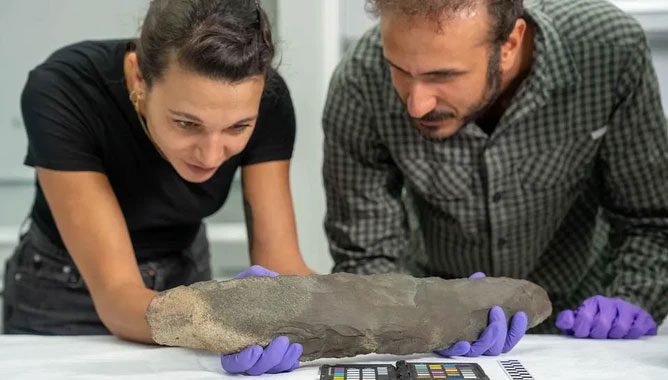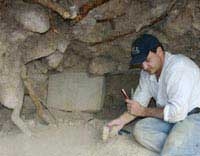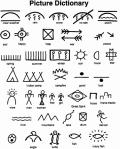Just as they were about to take a break after a long day of work in the scorching desert, Saudi Arabian archaeologists stumbled upon a treasure lying on the surface of a sand dune, potentially the relic of another species.
This was a stone axe dating back 200,000 years, with a unique appearance, an unparalleled archaeological artifact promising to unveil insights into the primitive, groundbreaking technologies that elevated humans to a superior species, distinct from the animal kingdom.
According to Live Science, the axe, made from basalt, was discovered in the Qurh Plain area, south of AlUla, a region in northwestern Saudi Arabia.

“The Giant’s Treasure” being examined by scientists in the lab – (Photo: ROYAL COMMISSION FOR ALULA (RCU)).
What is astonishing is the unusual size of the axe: measuring 51.3 cm long and 9.5 cm wide, it is the largest stone axe ever excavated.
Both sides of the axe are sharpened, indicating that it could be used for cutting or chopping.
Despite its giant-like appearance, the axe was crafted with care and from a selected type of stone, making it easy to handle with two hands.
According to archaeologist Ömer Can Aksoy, the project director, the axe has not yet been accurately dated, but based on the dating of other artifacts found at the same site, it is estimated to be around 200,000 years old.
Aksoy’s archaeological team “struck gold” in the last 15 minutes of their workday. Just as they were about to conclude for the day, two team members unexpectedly spotted the massive axe on the surface of a sand dune.
This discovery also served as a “marker treasure,” as after collecting it, the archaeologists decided to continue digging and found 13 smaller stone axes just beneath the surface.
Each team member had to remove their golden jackets to mark the artifacts since there was no prior preparation for finding such a significant number of “treasures” at once.
Though smaller than the great axe, the remaining artifacts were similarly impressive, resembling tools of giants.
An intriguing question arises: Who created them? This area may have been a overlapping habitat for various human species around 200,000 years ago, including our ancestors, Homo sapiens.
However, another name comes into suspicion: Homo erectus, another species belonging to the Homo genus that emerged around 1.7 million years before our species and has since gone extinct.
They are referred to as “upright man” because they were the first species of humanity to walk upright, resembling our modern posture and are believed to have been the first to create the most significant technological breakthrough: the ability to craft tools.
Archaeologists plan to seek answers through laboratory analyses, as well as in another excavation at the same site, set to begin in early 2024.





















































